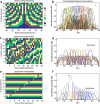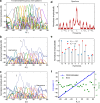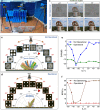Integrated sensing and communication based on space-time-coding metasurfaces
- PMID: 39984472
- PMCID: PMC11845482
- DOI: 10.1038/s41467-025-57137-6
Integrated sensing and communication based on space-time-coding metasurfaces
Abstract
Programmable metasurfaces (PMs), also called reconfigurable intelligent surfaces (RISs), are planar structures capable of dynamically manipulating electromagnetic waves in real-time. Regarded as a key enabling technology for implementing smart wireless propagation environments, PMs/RISs also serve as an ideal supporting platform for integrated sensing and communication (ISAC). Here, we propose two ISAC schemes based on a special type of PMs/RISs: space-time-coding metasurfaces (STCMs). By leveraging space-time-coding strategies, STCMs simultaneously control the propagation at the fundamental (carrier) frequency for reliable wireless communication and generate spatially distributed harmonics for sensing. The proposed schemes seamlessly integrate both communication and sensing on a shared hardware platform, eliminating the need for additional sensors. For experimental validation, we implemented an ISAC system using a 2-bit STCM operating at microwave frequencies. Experimental results align with theoretical predictions, confirming the practical viability and effectiveness of the proposed ISAC schemes for applications in communication, imaging, radar, and sensing systems.
© 2025. The Author(s).
Conflict of interest statement
Competing interests: The authors declare no competing interests.
Figures






References
-
- Cui, T. J., Qi, M. Q., Wan, X., Zhao, J. & Cheng, Q. Coding metamaterials, digital metamaterials and programmable metamaterials. Light Sci. Appl.3, e218 (2014).
-
- Wu, Q. Q. & Zhang, R. Towards smart and reconfigurable environment: intelligent reflecting surface aided wireless network. IEEE Commun. Mag.58, 106–112 (2020).
-
- Huang, C., Zappone, A., Alexandropoulos, G. C., Debbah, M. & Yuen, C. Reconfigurable intelligent surfaces for energy efficiency in wireless communication. IEEE Trans. Wireless Commun.18, 4157–4170 (2019).
-
- Basar, E. et al. Wireless communications through reconfigurable intelligent surfaces. IEEE Access7, 116753–116773 (2019).
-
- Di Renzo, M. et al. Smart radio environments empowered by reconfigurable intelligent surfaces: how it works, state of research, and the road ahead. IEEE J. Sel. Areas Commun.38, 2450–2525 (2020).
Grants and funding
LinkOut - more resources
Full Text Sources

